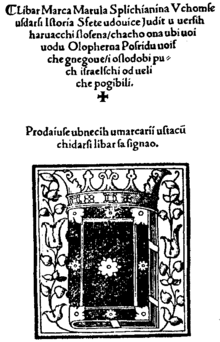Judita

Cover of the first edition of Judita
|
|
| Author | Marko Marulić |
|---|---|
| Country | Croatia, Republic of Venice |
| Language | Croatian |
| Subject | Story of Biblical Judith |
| Publisher | Guglielmo da Fontaneto |
|
Publication date
|
13 August 1521 |
Judita ("Judith") is one of the most important Croatian literary works, an epic poem written by the "father of Croatian literature" Marko Marulić in 1501.
The work was finished on April 22, 1501, and was published three times during Marulić's lifetime. The first edition was arranged by Petar Srićić of Split and was printed in Venice by Guglielmo da Fontaneto on August 13, 1521, that is, 20 years after it was written. One extant copy of the first edition is held in the Mala braća Franciscan library in Dubrovnik, and the other in the Zadar family Paravia's library, which is today a part of the Scientific Library of Zadar.
The second edition was edited by Zadar librarian Jerolim Mirković, published on May 30, 1522, and is illustrated with nine woodcuts depicting war scenes. The ninth woodcut is signed with the letter M, and it was therefore assumed that Marulić himself was the author of the woodcuts. One copy of Mirković's edition was given to the University Library by Ivan Kukuljević, and the other copy, still held in the Collection of Manuscripts and Old Books of the University Library, originates from the Kukuljević's legacy.
The third edition was printed on January 29, 1522, for the Dubrovnik librarian Jacomo di Negri. (Transposing the date from Venetian calendar, the publication date would be January 29, 1523. The only surviving copy of that edition is held at the Bavarian State Library in Munich.
The frequency of printing indicates that the text found its readership not only in Split, which had at most 200 literate citizens at the time, but in other Dalmatian centres. The poem contains 2126 dodecasyllabic lines, with caesurae after the sixth syllable, composed in six books (libars). The linguistic basis of the book is Split Čakavian speech and the Štokavian lexis, and the Glagolitic original of the legend; the work thus foreshadows the unity of Croatian language.
...
Wikipedia
